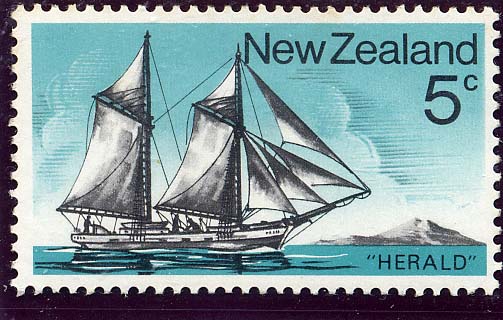Post
by aukepalmhof » Mon Oct 12, 2009 1:22 am
In his very interesting article in the latest Watercraft Philately, “The South Seas Missionary Ships”, Dan Rodlie gives the very brief details of the vessel HERALD, I found the following additional info on the ship in the book “Out of Auckland” by Clifford Hawkins, what follows is mostly copied from the book.
When the missionary vessel ACTIVE (New Zealand 1997 40c sg 2097)became a serious financial burden for Marsden and the Church Mission Society they sold her. And this left the mission in New Zealand dependent on visiting traders and whalers for their communication with New South Wales, an intolerable situation which prevailed until 1824.
Then the decision was made to build a new vessel for the Church Mission Society.
The Rev. Henry Williams and Gilbert Mair commenced building a 60 ton schooner at Paihia in 1824. It was a hard task without enough skilled labour to build a vessel. The difficulties were aggravated by the increasing hostility of the Maoris. A thoughtless carpenter swearing at a chief brought the Mission and the vessel almost to a catastrophic end.
The chief sought compensation for the insult from Williams because he, and not the carpenter possessed things worth appropriating as ‘utu’. In resisting the chief’s attempts at taking the desired articles Williams barely escaped with his life, and at least after a long deliberation the decision was made not to abandon everything at Paiha.
The schooner was launched on 24 January 1826 when three to four thousand Maoris gathered to witness the launching of the HERALD. A great number of them hoped that their services would be required to drag the hull to the water, and there was much consternation when after the dog-shores had been knocked away, the vessel glided into deep water.
The length of the keel of the vessel was 52 feet. She was not coppered, a very serious matter in worm infested waters. Copper sheathing was not available at new South Wales, and the Mission was unable to get any from England.
Three weeks after the launch she was under way for her maiden voyage to Sydney under command of Gilbert Mair. Henry Williams who was also on board that voyage was very pleased with the vessel sailing performances, due to light winds and insufficient sails the passage was slow, but when she arrived at Sydney, Marsden was offered £1.000 for the schooner, but he did not sell her.
After her return to the Bay of Islands a voyage was made loaded with pork and potatoes to Tauranga, she returned at the Bay of Islands on 3 July. The same day she sailed for Sydney. She made then altogether three cross Tasman voyages from the Bay of Island to Sydney.
On 15 March 1827 she passed the ASTROLABE under command of Dumont d’Urville, lying at anchor in the Bay of Islands.
Sailed 26 March 1827 again for Tauranga thereafter made an other three coastal voyages, before she made an other voyage to Sydney.
Early in 1828 the Ngapuhis tribe had attacked a number of Rotorua Maoris on a visit to Kawakawa and as they were in fear of further attacks, they sought refuge at Paihia. To prevent the trouble from spreading there a passage was promised them on the HERALD, and on 4 April it was deemed expedient to dispatch her without further delay. As one of the chiefs who had been at Paiha was not too pleased with the mission’s interference and wanted to have some say as to who went and who did not, embarkation was made secretly at night and the HERALD sailed under cover of darkness from the Bay of Islands for Tauranga on the 5th April.
She sailed on 2 May 1828 from the Bay of Islands bound for Hokianga, when she arrived at the heads, there was a high sea running, and the risk for entering the port was to high, so she stood off for two days.
Just before sundown on the 6th (a other source gives 26th May) the schooner stood in with a fair wind, while crossing the bar suddenly the wind failed, and the HERALD powerless was carried by the breakers on the rocks. During high tide and by heavy seas the schooner was cast high on the beach.
The local Maoris after assisting the crew ashore, robbed them of their clothing and complete pillaged the wreck, cutting away the rigging wrecking the cabin and leaving behind only the bare hull.
When some days later Williams and a strong party visited the HERALD she was beyond salvage. When Williams asked the chiefs they had little to say in justification of their conduct. The chiefs blamed each other’s for the damage done to the vessel, and this they acknowledged was wrong, but the plundering of loose articles they maintained was in accordance with their law.
Source New Zealand Shipwrecks by C.W.N. Ingram.

